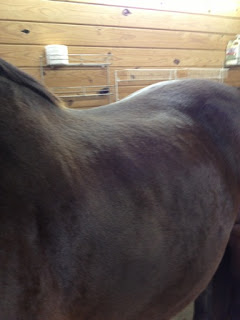 |
In recovery a few minutes before
they told me to walk. |
While you may not consider my knee replacement a "horse" or
"dressage" topic to me it is ... because it was the day I realized
that I was not enjoying or able to ride my horse that I knew it was time to
head under the knife. I tried to make it work by finding new ways to get on and
off and taking pain meds but in the end it was just too painful to tack him up
and ride and I was riding less and less.
It felt like a chisel was permanently installed in my kneecap.
<Warning up high in this blog entry… I put some pics of the knee as it is
healing at the bottom.
If you are squeamish
you may want to stop halfway through.>
I know many riders face this same decision so perhaps a log of how mine went
might be helpful to someone.
My surgery was eight days ago last Monday. I arrived at the hospital at 8 am
for pre-op, bloodwork and to confirm for the second time that week that I was
not pregnant. (No chance of it but they didn't believe me.) The lack of fluids
through the night made the IV difficult to place but by 10 am and with the help
of the anesthesiologist; I had an IV and was bent over so they could place an
epidural in my spine.
I remember bending
over and the stick and that must have been when they knocked me out because the
next thing I remember was waking slightly during the surgery to have them tell
me that it was nearing the end of the surgery.
I had an epidural so I could very lightly be put under (making it easier
to come out of anesthesia).
I woke up a
couple of times during surgery but it was like being VERY drunk.
I didn’t care in the least that I was in the
OR.
By 12:30 I was in the recovery room and by 2:30 I was walking with a walker
to the bathroom.
I have to admit I was a
little terrified when they asked me to walk and put weight on a leg they had
just chopped but it turns out the pain meds were still working well and I did
pretty well getting there.
I had what is called a partial knee replacement which means that they
replaced only the joint on the inside of my knee – the area of my knee with the
majority of the arthritis and the cause of my pain.
The recovery is generally faster and there is
much less blood loss.
By a little after 3 pm I was in the passenger seat of the car and heading
home.
The surgery was a little over an
hour away from our house and I rode all the way home with my eyes shut praying
I wasn’t going to throw up.
(I didn’t but I had a bag ready.)
We had to pick up my son from school on the way.
As he approached the car, “Mom, what is wrong
with YOU?”
“I just had surgery… I don’t feel well.”
“Oh… well you look like you are dying.”
Thanks.
You can always count on
teenage sons for the truth.
The first couple of days were not fun.
I had physical therapy the first day and they spend most of it trying to
see how far they can bend your knee.
I was
sure the stitches barely holding my swollen knee together were going to burst
in the therapists face.
I couldn’t believe
he wasn’t ducking.
Each day gets better though.
You have
a decent day and decide that sure… you can go to work for a couple of
hours.
I mean all I do is sit -- its not like I work construction.
What’s the difference between sitting there
and sitting at home?
I tried going for
two hours on Tuesday and paid for it all night.
No sleep because the pain meds just couldn’t keep up.
I haven’t seen my horse since the night before the surgery.
I hope he remembers me.
I am hoping that next week I can start
driving again and can stop relying on wonderful friends who are currently
caring for my horses.
Until I wean
myself off the pain meds I can’t drive.
Right now I am down to a little less than half the dose I was on the
first week so I am getting there.
The good news is that although my knee hurts its completely different than
the hurt before the surgery.
Instead of getting
worse every day … its getting better every day.
I have high hopes that I will be riding soon and will be doing it pain
free.
The goal is to be able to bend my
knee at least 120 degrees and extend it completely flat at 0 degrees.
At my therapy session yesterday I was at
108 degrees flexion and 2 degrees extension.
I can’t wait to
post the entry about
my first ride after surgery.
The sooner
the better.
The picture to the left is the day after surgery. The word "Yes" I had to write
on there to make sure they replaced the correct knee. The knee to the right
is a week after surgery. The bruising didn't start showing up until
about day three.































